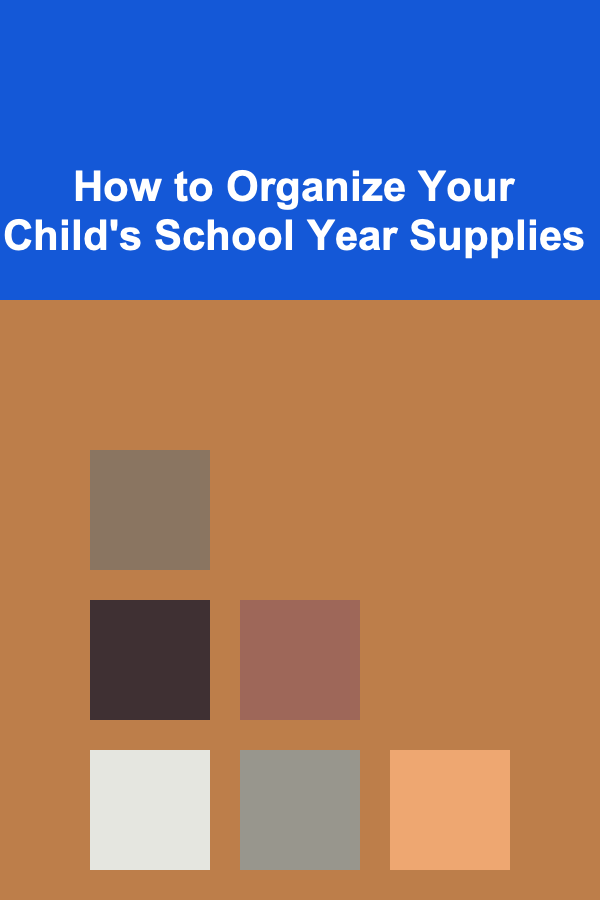
How to Organize Your Child's School Year Supplies
ebook include PDF & Audio bundle (Micro Guide)
$12.99$7.99
Limited Time Offer! Order within the next:

As the school year approaches, parents and guardians often find themselves inundated with a variety of supplies---everything from textbooks to art materials, notebooks to lunchboxes. An organized supply system not only helps your child locate what they need but also promotes responsibility, reduces stress, and fosters a conducive learning environment at home. This comprehensive guide will explore effective strategies for organizing your child's school year supplies, ensuring a smooth transition into the academic year.
The Importance of Organizing School Supplies
1. Promotes Responsibility and Independence
By organizing their supplies, children learn to take responsibility for their belongings. They become independent in managing their materials, fostering essential life skills.
2. Reduces Stress and Anxiety
A clutter-free space allows both parents and children to locate supplies quickly and efficiently, minimizing the stress that often accompanies the start of the school year.
3. Enhances Study Habits
An organized study area encourages good study habits. When children can easily access their materials, they're more likely to engage in productive study sessions.
4. Encourages Creativity and Exploration
When supplies are well-organized, it's easier for children to explore their creative side without being overwhelmed by clutter.
5. Saves Time and Money
Organizing prevents the unnecessary purchase of duplicate supplies. A clear inventory of what you already have saves time when shopping and ensures you buy only what's needed.
Steps to Organize Your Child's School Year Supplies
Creating an organized system for school supplies involves several strategic steps. Let's delve into each component.
Step 1: Assess Existing Supplies
Before creating a new organizational system, assess what supplies you currently have:
A. Gather All Supplies
Collect all school-related items from around the house---under beds, in closets, or scattered throughout different rooms.
B. Sort Items
Group supplies into categories such as:
- Writing Utensils: Pens, pencils, markers, highlighters
- Paper Products: Notebooks, folders, loose-leaf paper
- Art Supplies: Crayons, paints, glue
- Backpacks and Lunchboxes
- Technology: Tablets, calculators, chargers
C. Evaluate Condition
Check each item for usability:
- Are there broken crayons or dried-out markers?
- Is any paper damaged or torn?
- Do you have enough of each type of supply?
Step 2: Declutter and Purge
Once you've assessed existing supplies, it's time to declutter:
A. Make Decisions
For each category, decide what to keep, donate, or throw away:
- Keep: Usable items in good condition
- Donate: Excess supplies that could be useful to others (local schools, community centers)
- Discard: Items that are broken, expired, or unusable
B. Create a "Needs List"
After purging items, create a list of additional supplies needed for the upcoming school year based on your child's grade level and school requirements.
Step 3: Choose an Organizational System
Select an organizational system that works best for your family's needs:
A. Storage Solutions
Invest in appropriate storage solutions that are accessible for your child:
- Bins and Baskets: Use labeled bins for different categories of supplies. Clear bins allow visibility.
- Drawer Organizers: Utilize drawer dividers to separate smaller items like pens and pencils.
- Shelving Units: Install shelving in a closet or dedicated space to store larger items like backpacks and binders.
B. Portable Caddies
Consider using portable caddies for younger children. These allow them to carry supplies to different areas of the home for homework or projects.
Step 4: Designate a Study Area
Having a specific study area is crucial for your child's focus and productivity:
A. Choose the Right Location
Identify a quiet space in your home free from distractions, such as a separate study room, a corner in the living room, or even a section in their bedroom.
B. Create a Comfortable Setup
Ensure the study area includes:
- Desk and Chair: Select ergonomic furniture that is age-appropriate.
- Good Lighting: Natural light is ideal, but ensure there's adequate artificial lighting for evening work.
- Supplies Within Reach: Keep commonly used items close at hand to minimize disruption.
Step 5: Categorize and Label Supplies
A systematic approach to categorization helps maintain organization throughout the school year:
A. Color Coding
Use color coding to help your child easily identify different subjects or materials. For example, use blue folders for math, red for science, and green for language arts.
B. Labels
Label bins, shelves, and containers clearly. Involve your child in the labeling process to reinforce their understanding of where everything belongs.
Step 6: Implement a Tracking System
Keep track of supplies and assignments effectively:
A. Supply Inventory Checklist
Create a checklist of supplies that your child uses regularly. Hang this checklist near their study area so they can easily monitor what needs to be replenished.
B. Homework Planner
Encourage the use of a planner or digital tool to track assignments, deadlines, and important dates. This habit promotes responsibility and organization.
Step 7: Maintain Order Throughout the School Year
Maintaining an organized system requires ongoing effort. Here are ways to keep things tidy:
A. Weekly Check-ins
Schedule weekly check-ins with your child to review supplies and study areas. Make it a fun routine to assess what's working and what needs adjustment.
B. End-of-Term Purge
At the end of each term, sit down with your child to evaluate supplies. Discard empty packets, broken items, or anything no longer needed.
C. Teach Responsibility
Encourage your child to take responsibility for their space. Teach them to return items to their designated spots after use.
Creative Ideas for Organizing School Supplies
Once you've established a basic organization system, consider these creative ideas to enhance functionality and aesthetics:
1. DIY Supply Containers
Transform empty jars or boxes into stylish storage containers. Decorate them with paint, washi tape, or fabric to match your child's personality.
2. Magnetic Boards
Install a magnetic board in the study area to hold papers, reminders, and small supplies. This visual organizer keeps important items front and center.
3. Pegboards
Utilize pegboards for hanging supplies like scissors, rulers, and art materials. This method maximizes vertical space while providing easy access.
4. Rolling Carts
Invest in a rolling cart that can serve as a mobile study station. Store supplies in the cart, making it easy to move from room to room.
5. Reward System
Incorporate a reward system to motivate your child to keep their supplies organized. Praise them for taking initiative, or offer small rewards for maintaining order.
Common Challenges and Solutions
While organizing school supplies can greatly enhance your child's educational experience, challenges may arise. Here are some common issues and potential solutions:
Challenge 1: Overwhelming Amount of Supplies
Solution: Start small by focusing on one category at a time. Break the decluttering and organizing process into manageable parts.
Challenge 2: Resistance from Your Child
Solution: Involve your child in the organization process. Allowing them to have a say in how to organize their supplies fosters ownership and responsibility.
Challenge 3: Maintaining Organization
Solution: Establish a regular routine for checking and reorganizing supplies. Make it a family activity to reinforce the importance of keeping things tidy.
Challenge 4: Limited Space
Solution: Optimize vertical space with shelves or wall-mounted organizers. Consider under-bed storage for items that are not frequently used.
Real-Life Examples of Organized School Supply Areas
To inspire your efforts in organizing school supplies, here are a few real-life examples:
Example 1: The Color-Coordinated Drawer
In one family's home, each drawer in a small desk is color-coded based on subject matter. Folders, notebooks, and writing tools are neatly arranged in colors that correspond with classroom subjects, making it easy for children to grab what they need.
Example 2: The Portable Caddy
A busy parent created a portable caddy filled with essential supplies for her child. This mobile unit can be carried from room to room, ensuring her child always has access to materials whether doing homework in the kitchen or studying in their bedroom.
Example 3: The Wall-Mounted Organizer
In a shared space, a family installed a wall-mounted organizer with bins for each child. Labels mark each bin, indicating ownership of supplies. This method keeps the floor clear and makes it easy for each child to find their supplies independently.
Conclusion
Organizing your child's school year supplies is an investment in their education and personal growth. A well-structured and aesthetically pleasing setup encourages responsibility, creativity, and independence while reducing stress for both parents and children alike.
By following the steps outlined in this guide---from assessing supplies to implementing an ongoing maintenance strategy---you'll create a functional workspace that enhances your child's learning experience and prepares them for success throughout the school year. Start today, and watch as your child flourishes in their organized and supportive environment!

10 Simple Tips for Effective Meal Planning on a Budget
Read More
How to Keep Your Home's Insulation in Top Condition
Read More
How to Keep Your Sewing Room Child-Friendly and Safe
Read More
How to Protect Your Family's Finances with the Right Insurance Plans
Read More
How to Set Financial Goals and Stay on Track
Read More
Turning Your Deep Learning Knowledge into a Profitable Venture
Read MoreOther Products

10 Simple Tips for Effective Meal Planning on a Budget
Read More
How to Keep Your Home's Insulation in Top Condition
Read More
How to Keep Your Sewing Room Child-Friendly and Safe
Read More
How to Protect Your Family's Finances with the Right Insurance Plans
Read More
How to Set Financial Goals and Stay on Track
Read More